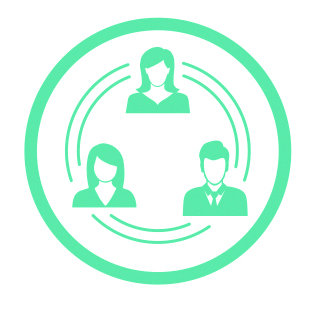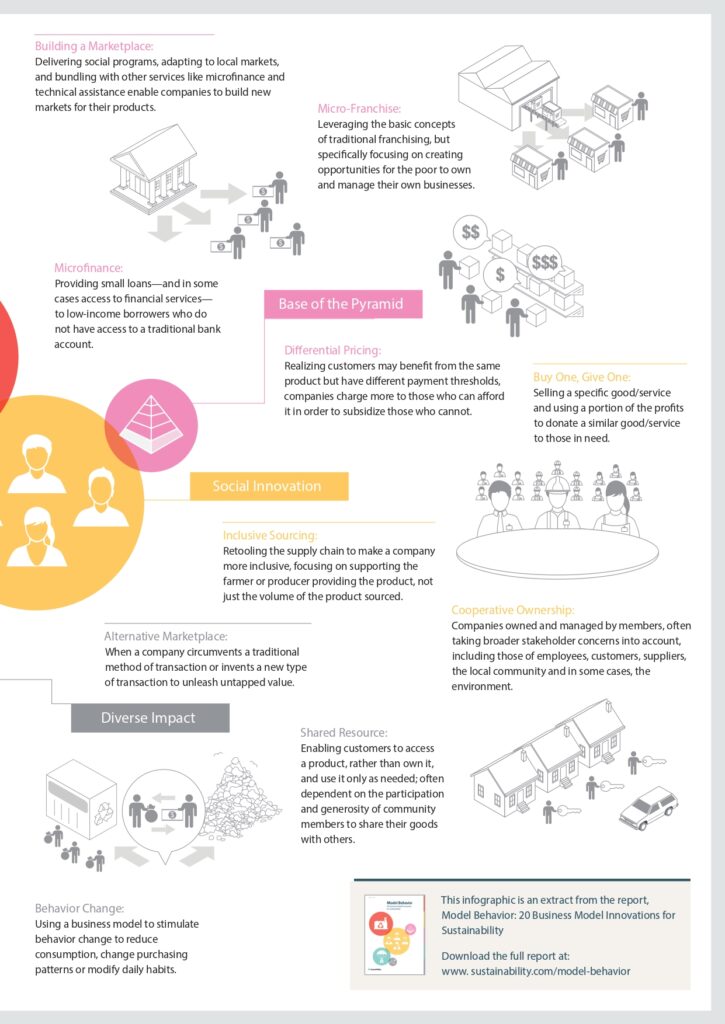Business Model Innovations
Business model innovation today is being driven by challenging business conditions and other emerging factors that create both constraints and momentum that necessitate or encourage new approaches that result in more sustainable outcomes. Resource scarcity, climate change, urbanization and changing demographics make it difficult for many companies to maintain the status quo. They also present an opportunity to do business differently—and more sustainably. Meanwhile, emerging factors such as digitization and the rise of the collaborative and circular economies point to increasing momentum that may put the wind in the sails of companies that choose to harness these forces.
Three Key Elements for New Sustainable Business Models

1. The External Landscape
Business model innovation today is being driven by challenging business conditions and other emerging factors that create both constraints and momentum that necessitate or encourage new approaches that result in more sustainable outcomes.
Resource scarcity, climate change, urbanization and changing demographics make it difficult for many companies to maintain the status quo. They also present an opportunity to do business differently—and more sustainably. Meanwhile, emerging factors such as digitization and the rise of the collaborative and circular economies point to increasing momentum that may put the wind in the sails of companies that choose to harness these forces.
Examples of constraints:
- Urbanization has also put more strain on companies’ infrastructure and distribution networks within cities, making it more difficult to meet demand. The prospect of urban opportunity lures rural workers to cities; as a result, many companies, particularly those dependent upon smallholder agriculture, such as Nestle, Mars Inc, Mondelez International and Syngenta, grapple with workforce and supply instability.
- Growing water scarcity has pushed companies like Coca-Cola to hedge their bets by investing in companies like Keurig Green Mountain that might enable them to reduce centralized water extraction in water-poor communities through self-service home soda makers but still get their products into the hands of consumers.
- Novelis, Renault and Waste Management are adopting closed loop models in the face of market volatility.
Examples of momentum:
- Andela, a growing social enterprise in Nigeria, uses technology to address a skills gap—the shortage of qualified software developers. Andela has created a four-year program that provides remote training in basic coding. Students then divide their time between schoolwork and real projects for IT companies in need of talent. Clients include Microsoft and Segovia.
- Earlier this year, IBM announced a partnership with Yarra Valley Water, the largest water and sanitation utility in Melbourne, Australia, to enhance the management of the utility’s assets and customer service to over 1.7 million people and 50,000 businesses. The partnership will leverage IBM’s experience formulating cloud-based systems, combining it with their skills in big data collection and analytics to make Melbourne’s water management smarter, thereby reducing the cost of managing water by 15%

2. The Company’s Internal Culture

Culture plays a significant role in enabling teams inside firms to respond to these external conditions and create new models. A review of mainstream innovation literature cites four factors influencing corporate environments to allow for innovation: supportive senior leadership, non-hierarchical structures, freedom to fail, and an ethos that encourages collaboration. Internal innovators can leverage and/or work to foster these elements to drive business model innovation for sustainability.

Examples of non-hierarchical structures in companies:
- IDEO, a leading design and innovation consulting firm, attributes part of its success to its flat organizational structure that allows all employees to contribute and build upon each other’s ideas. The company’s mentoring system, or reverse mentoring where a junior person mentors someone more senior, is a unique aspect of this structure
- At Valve no employee reports to anyone else; decisions are made through consensus and spontaneous subcommittees
- Likewise at Gore, a team-based, flat-lattice organizational structure allows open communication. Leaders emerge naturally, appointed by their peers rather than top-down promotions
Example of ethos of collaboration:
- At Intel, part of the responsibility of the corporate finance unit is to apply its expertise to help quantify the impact of sustainability activities across the business. This internal collaboration is advantageous for achieving effective integration of sustainability into the company and its business model.
- Many companies have experienced much higher levels of innovation when collaborating outside their four walls. For example, in Zambia, the pharmaceutical company GlaxoSmithKline (GSK) and Barclays bank are removing the financial barriers to healthcare access, while simultaneously building a new marketplace by offering micro-insurance and support to new businesses. The aim is to create improved economic conditions for growth, providing value to each company and the communities in which the program is rolling out.



3. The Actions of the Innovator
Our interviews and research, as well as our experience running innovation workshops, demonstrate that thoughtful and ambitious sustainability leaders can foster business model innovation thinking, if not entirely new business models. These entrepreneurial leaders build networks and connections inside a company—a measure of success for one such internal changemaker is how many people across business units he can connect to one another to pursue business model innovation. The leaders introduce the concept and promise of business model innovation through tools that highlight areas of risk and opportunity for their company. They focus dialogue on value creation rather than new products or outputs.
Description of Tools:
- Mine the Network: The myth of the “lone innovator”—that only individual geniuses can produce groundbreaking innovations—is subsiding and for good reason. Today, innovations are increasingly brought to market by whole networks of internal collaborators or even networks of firms that operate in a coordinated manner. However, corporations are often organized into hierarchies and silos, causing challenges for those trying to shift mindsets or influence a new way of doing things. When trying to get buy-in for a new idea or to encourage teams to generate breakthrough ideas, tapping into the right networks and bringing diverse subsets of the business to the table is vital.
- Map the Model: A key step towards business model innovation lies in mapping the current business model, sustainability priorities, and potential risks that lurk outside the company. Surprisingly, studies show that between 60% and 85% of most firms’ employees do not know or understand their organization’s strategy, including its business model. Simply educating employees about how the company generates value and examining this through a sustainability lens, amongst other lenses, can advance dialogue about business model innovation.
- Focus on Value: Whereas many companies focus solely on financial value creation, business model mapping with a lens focused on social and environmental value creation, too, can more effectively convey a company’s externalities, positive and negative, and demonstrate whether it is equipped to be part of a sustainable future.
- Build the Business Case: As with any new innovation, the business case for action must be clear when gaining internal buy-in for a business model innovation focused on sustainable outcomes. Selling an innovation internally, with solid financial estimates, that are competitive with mainstream models or programs, will enable it to gain broad appeal and turn an idea into action.
- Align Metrics: Metrics are an important driver for innovation at the corporate level, but they can also incentivize innovation for sustainability by steering individual performance. Aligning employee performance metrics with innovation goals, for example, by making them part of a quarterly or annual performance review, is an important enabler for business model innovation. If employees are not incentivized to innovate, or are discouraged from innovating because their performance rating is more dependent on other metrics, this can block progress towards a business model shift.
This report focuses on telling the stories of companies that have shifted their business model to become more sustainable because it made business sense. Through several in-depth case studies of large, multinational companies from multiple industries—Fibria, Novelis, Starbucks and Syngenta—we put these points into relief and reveal the process and evolution involved in transforming a business model. In the case studies throughout the report, readers will learn about how shifting to recycled aluminum made more financial sense for Novelis than continuing to source virgin, primary aluminum. Starbucks had to differentiate itself from competitors at the high and low end of the market and green building provided a solution. Fibria, the largest pulp company in the world, realized that while demand for its traditional products would remain strong for many years, it was risky to depend on historic patterns of demand. The company had to shift its mindset. Syngenta changed its sales approach as part of a larger effort to retain its core customers, farmers.
